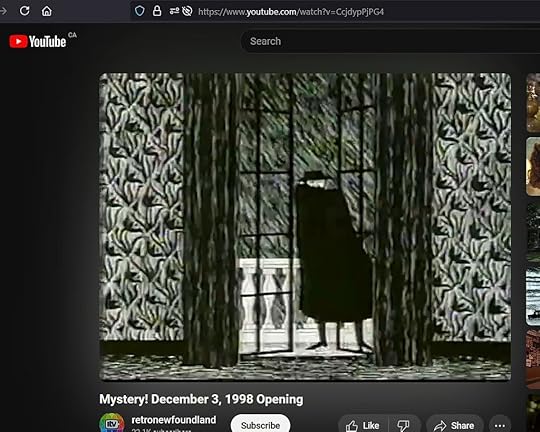Edward Gorey, master of the macabre
I suppose fiction writers must seem a little strange to people, spending much of our time inside our heads in imaginary worlds where we make up weird and wonderful tales to entertain you with.
Especially those of us who specialize in the eerie and macabre. We love to twist your expectations and mess with your heads. We get excited when something sends a shiver down our spine, because we know it will do the same to you.
We paint in word pictures so that you can see what we’re seeing, anything from sunny and pleasant to dark and gruesome. But what happens when a writer and an illustrator of the macabre are combined into one person?
Edward Gorey.
 Screenshot of a YouTube post of the PBS Mystery! intro sequence – watch the entire clip at https://www.youtube.com/watch?v=CcjdypPjPG4
Screenshot of a YouTube post of the PBS Mystery! intro sequence – watch the entire clip at https://www.youtube.com/watch?v=CcjdypPjPG4I was first introduced to the weird art of Edward St. John Gorey through PBS Mystery!, which used his animated imagery extensively for its 1980 season, and I became an instant fan. Gorey’s gloomy, imaginative black-and-white artwork was combined into a delightfully atmospheric animated title sequence that introduced the show each week. There were Victorian-looking detectives prowling around a creepy country mansion, a cluster of people in macabre 1930s-era clothing looking like they were attending a party at Dracula’s house, a pair of legs slowly sliding into a murky pond, and lots of stormy weather. Gorey admired mystery writer Agatha Christie, and he put his love of spoofing the genre to good use for this project.
He was born in Chicago, belying his quaintly English drawing style. His father was a journalist briefly, divorced from his natural mother, but his stepmother was Corinna Mura, a cabaret singer and actress whose small claim to fame was in the movie Casablanca as the woman in Rick’s Café Américain who played the guitar while singing the French national anthem.
But Gorey claimed to have gotten his artistic talent from his maternal great-grandmother, Helen St. John Garvey, who was a nineteenth-century greeting card illustrator (although her work was a far cry from Edward’s morbid style).
In an interview with Dick Cavette, Gorey said he first picked up drawing tools at the age of a year and a half; he also taught himself to read a couple of years later. By the age of five he’d read Alice in Wonderland and Dracula, which apparently influenced his burgeoning artistic style. (The former, though a children’s book, is incredibly weird.)
He began making drawings during high school, and studied at the Chicago Art Institute for a single semester before being inducted into the U.S. Army in 1943 and serving in World War II in Utah as a company clerk. After his release, he attended and graduated from Harvard. Moving to Manhattan, Gorey worked in the art department of Doubleday Anchor, where he illustrated many works you’ll recognize, including Bram Stoker’s Dracula and H. G. Wells’ The War of the Worlds.
He’d tried writing novels, unsuccessfully, but that was fortuitous for the legion of fans of his artwork, because he switched to little illustrated novellas. He met Frances Steloff, founder of the Gotham Book Mart, who liked unconventional authors and was willing to carry his books. Eventually his work drew the attention of critic Edmund Wilson, who, in a review in The New Yorker, described Gorey’s work as “surrealistic and macabre, amusing and somber, nostalgic and claustrophobic, poetic and poisoned.”
From there Gorey’s career as an illustrator and sometime author of weird little books took off, but I think it was arguably his artwork for PBS that catapulted him to fame.
If you watch the Dick Cavett interview on YouTube, Gorey seems somewhat uncomfortable in front of the camera, even though in daily life he was not a shy man, striding about in full-length fur coats with hippy-style clothing underneath. He didn’t make the best interviewee – he even admitted that he had a tendency to ramble on – and Cavett didn’t give him enough direction. The interview gets a little interesting about nine minutes in, but I think only the most dedicated Gorey fans will watch the whole thing.
In 1983, Gorey moved permanently to Cape Cod, first to Barnstable and then to a 200-year-old house in Yarmouthport, Massachusetts, that had been build by a sea captain. You can see the interior on YouTube in a short called Visiting the Edward Gorey House. It’s an interesting look at Gorey’s life at home, including a peek upstairs (where the public isn’t allowed) at his studio and his book-strewn television room. He remained there for the rest of his life, eating breakfast and lunch every day at a local diner named Jack’s Outback, which is now filled with Gorey memorabilia. He never married, and although he said he supposed he might be gay, he doesn’t seem to have had any relationships. It sounds like he was asexual more than anything else. There’s also an intriguing article about Gorey and the house on Atlas Obscura.
Instead, he lived with a variety of cats and collected not just books (he had thousands) but all manner of odds and sods like lobster floats as well as a lot of artwork. He said his own art was heavily influenced by the cross-hatch technique of John Tenniel in Alice in Wonderland, and the drawings in Wind in the Willows and the Winnie-the-Pooh books. If you want to see more of Gorey’s artwork, you can watch a collage of the Mystery! title sequences on YouTube, as well as a delightful presentation by Vermont Humanities called Mark Dery on “Edward Gorey’s Morbid Nonsense“.
Another fun site to visit online is the Gorey Store, run by the administrators of Gorey’s Yarmouthport house. There you can browse through his books, artwork turned into all kinds of things to wear and decorate your own home with, even stuff for children (highly ironic, as all the children in his stories invariably met their demise in strange, rhyming ways). I particularly like the Dracula Collection, which is drawn with his usual odd but very cool whimsy.
 Screenshot of Edward Gorey merchandise, specifically the Dracula Toy Theater, on the Gorey Store website, to indulge all your innate Gorey-ness
Screenshot of Edward Gorey merchandise, specifically the Dracula Toy Theater, on the Gorey Store website, to indulge all your innate Gorey-nessIn the interview, Gorey certainly displayed a dry sense of humour that definitely showed up in his artwork, even if he didn’t see it. When a publisher once rejected one of his books because it wasn’t funny, Gorey said, “It wasn’t supposed to be, what a peculiar reaction”.
He probably gave the best description of his work: “My favorite genre is the sinister-slash-cozy. I think there should be a little bit of uneasiness in everything because I do think we’re all really in a sense living on the edge. So much of life is inexplicable. Inexplicable things happen … and you think, if that could happen, anything could happen.”
Explore more about Edward Gorey and his art online at the Vanderbilt University G is for Gorey: The Remarkable Worlds of Edward Gorey exhibit.



